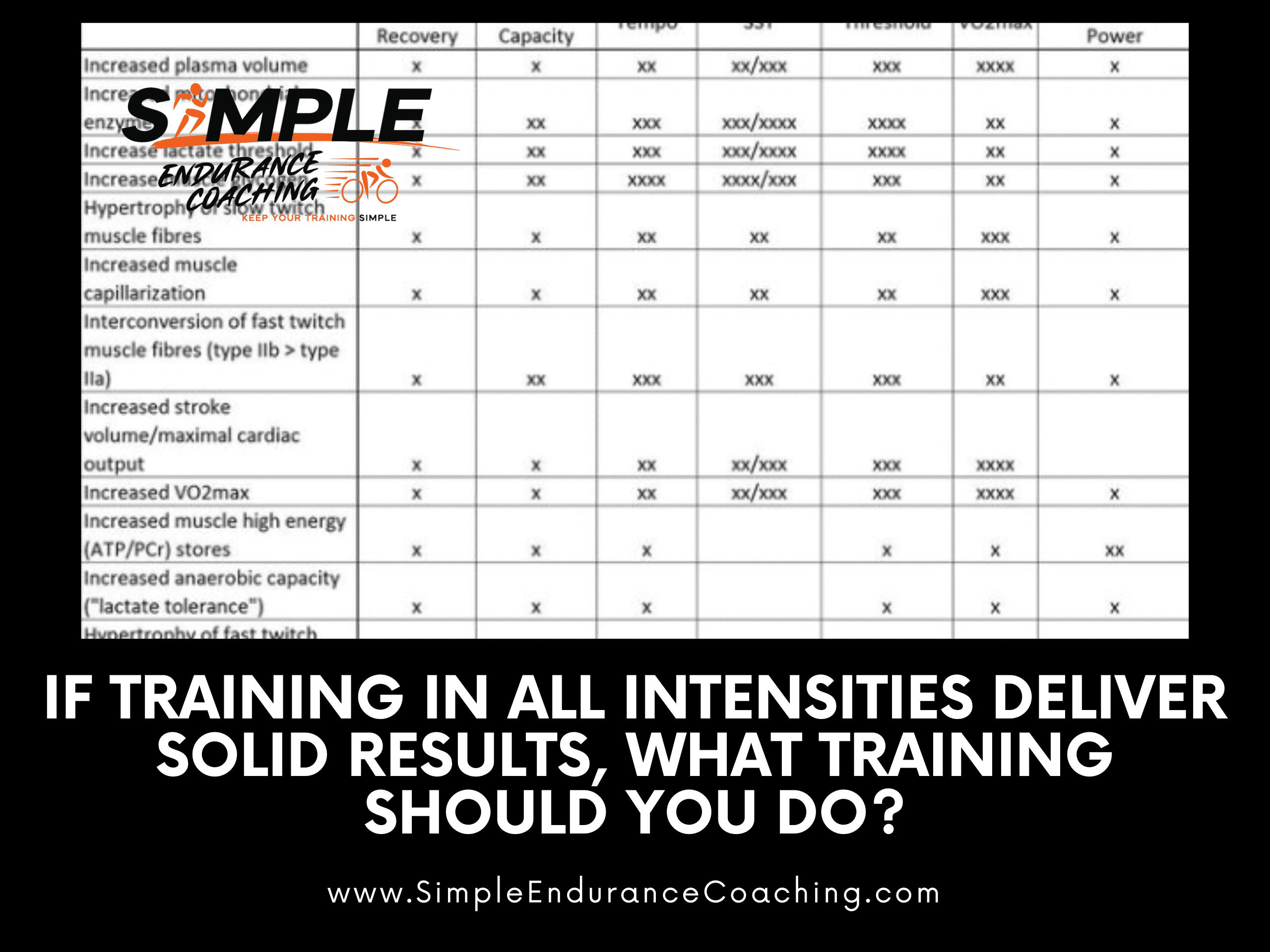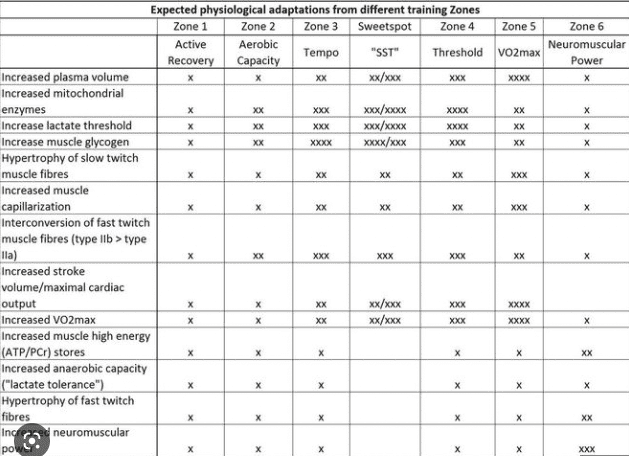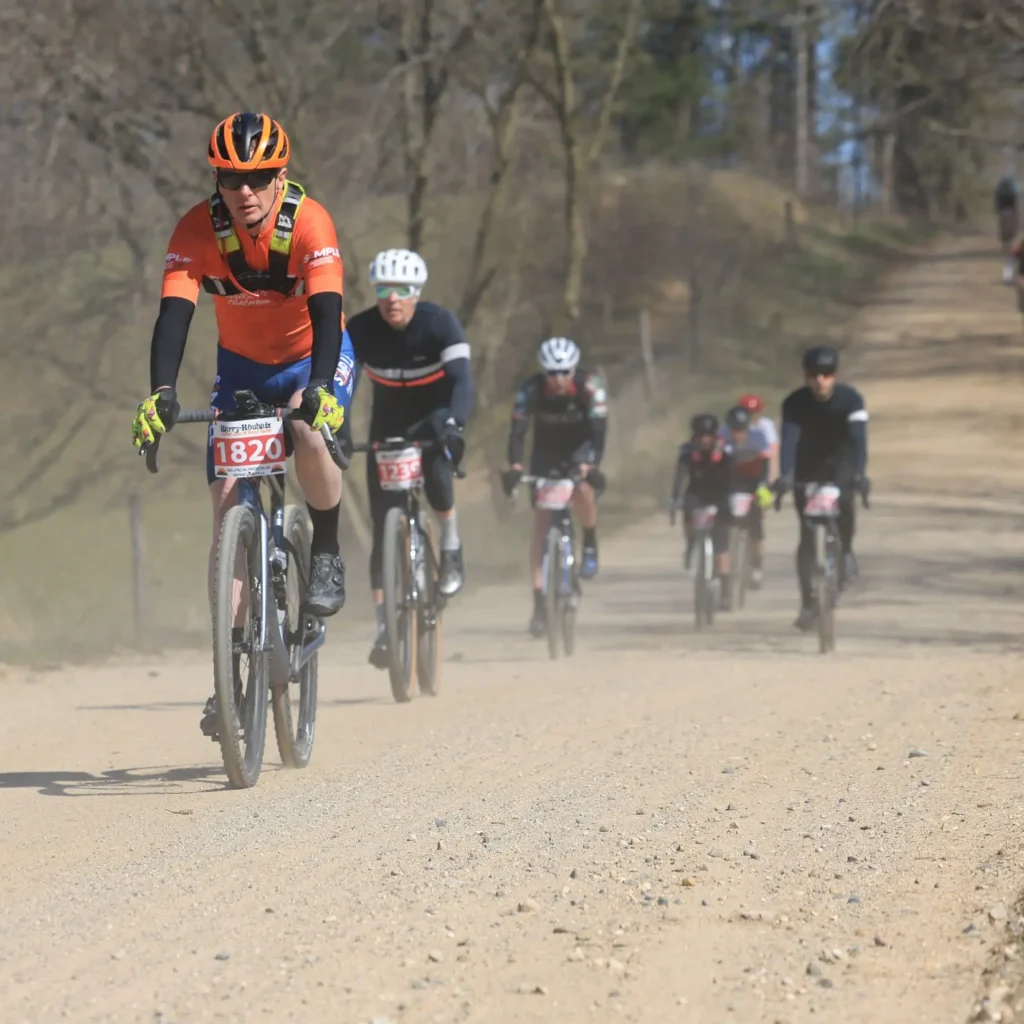If Training Intensities Delivers Solid Results, What Training Should You Do?
Training in higher-intensity zones usually brings about more positive adaptations.
Yet if you do too much intensity, you’ll stagnate and/or burn out.
So we learn two things from this: One, we need a balance of intensity and endurance, and two, we can target certain adaptations, such as increasing VO2max by improving cardiac output, by optimizing your training in certain domains.

Use training intensities to match your goals
In a recent blog post, I wrote about the different thresholds that exist between exercise domains and how to use them.
If you can find your first and second thresholds, you’ll be able to better target your training zones to get the kind of adaptations you’re looking for.
In 2003, Dr. Andrew Coggan prepared a paper that eventually turned into the book Training and Racing with a Power Meter.
In his initial paper, linked here, Coggan published a chart that has now become kind of ubiquitous.
With the checkmarks being the amount of adaptation, it’s clear adaptation happens in nearly every training zone – and the zones are based on physiological domains.
Zone 1 and 2 tend to be in the Moderate Zone, Zone 3 and 4 are in the Heavy Domain, Zone 5 is the Severe Zone, and Zone 6 and 7 are in the Extreme Zone.
Please remember that the physiological domains try to describe the changes in the body that occur at different intensities, while training zones are descriptions of how to train.
Again, the point of understanding all of this is to understand the purpose of your workouts.

Dr. Skiba shows similar adaptations for different training intensities
In his book Scientific Training for Endurance Athletes, Dr. Philip Skiba builds his own chart of primary adaptations, which I summarize here:
Moderate Domain Adaptations (Zones 1 and 2)
- Increased muscle capillarization
- Increased mitochondrial enzymes in Type 1 muscle fibers. This means the mitochondria are better able to use fat as a fuel source rather than carbohydrates.
- Increased mitochondria size and number
- Increased fatigue resistance
- Stronger Type I and IIA muscle fibers
- Maximized metabolic fitness
Heavy Domain Adaptations (Zones 3 and 4)
- Improved lactate threshold
- Improved glycogen storage and use
- Improved economy
- Improved VO2max
- Increased Critical Power
- Increased size and capillarization of Type I/II muscle fibers
- Conversion of Type IIX to Type IIA
- Increased cardiac output
- Increased mitochondria size and number
Severe Domain Adaptations (Zone 5 and 6)
- Improved VO2max
- Improved Critical Power
- Improved glycogen utilization
- Increased size of Type I/II fiber
- Increased size and capillarization of Type I/II muscle fibers
- Increased oxidative enzymes
- Increased mitochondria size and number
Extreme Domain Adaptations (Zone 6 and 7)
- Increased capillarization Type I/II fibers
- Increased W’
- Increased peak power output
- Fiber shift from Type I to Type IIX fibers
- Improved glycogen storage
- Improved neuromuscular system
- Improved muscle creatine phosphate
If you know the adaptations you need, target them with specific training
If you know the adaptation that you’re looking for, you can figure out the kind of training you need to do.
For example, if you’re looking to maximize the amount and size of your mitochondria and the mitochondrial enzymes in order to improve fatigue resistance, you should spend your training time in Zone 3 and 4.
However, if you train in Zone 3 and 4 a lot, you’re going to be fatigued.
Our bodies simply can’t handle that much training stress.
This is why Zone 2 work is so important: if you spend most of your training time in this zone, you can create the stress to cause adaptations, but not so much that you are fatigued!
That means you can do the endurance work more often.
And if you try to train in Zone 3 and 4 all the time, you’re going to build up so much fatigue that you’re no longer able to work hard enough to do the intensity.
Most of your training should still be endurance
The goal of training, then, is to go slow most of the time, and when it’s time to go hard, go hard, particularly in Zone 4.
So here’s what I suggest you take from all of this.
- Most of your training should be in Zone 2. While other zones produce more adaptations, Zone 2 allows for consistent training that builds the key adaptations like increased number and size of mitochondria, increased capillarization, fatigue resistance, and metabolic capacity (particularly in using fat as a fuel source).
- If you have time constraints, Zone 3 intervals can “replace” some of the Zone 2 endurance training.
- If you need to improve your FTP/Critical Power, you need Zone 4 intervals. Zone 4 threshold rides provide a lot of bang for the buck, but they also bring on a lot of fatigue.
- If you need to increase your cardiac output and VO2max, you need to do Zone 5 all-out intervals.
- Strength training and yoga, which are essential parts of endurance training, both have different adaptations, particularly with muscle fiber strength.
So here are three things to consider about training zones and physiological domains:
- Nearly all training produces similar adaptations. The size of the effect in the adaptation changes with exercise intensity.
- While intense training produces the most adaptation, it also produces the most fatigue. So you need a blend of different intensities for your training.
- Endurance training produces a lot of the desired adaptations without as much fatigue. Most of your training should be endurance training to get the most bang for your training buck.
Want to know more about training intensities?
If you liked this article, please share it with others.
Do you have questions? Email me at paulw at SimpleEnduranceCoaching.com
I support a limited number of cyclists and runners achieve their goals with more strength, endurance, and mobility.
Contact me or sign up for Virtual Coffee so we can discuss your goals, ask questions, and talk about making your endurance training more effective, fun, and Simple.
You can also opt-in to receive my weekly blog posts about what works in endurance sports.
Paul Warloski is a:
- USA Cycling Level 3 Coach
- RRCA Running Coach
- Training Peaks Level 2 Coach
- RYT-200 Yoga Instructor
- Certified Personal Trainer




